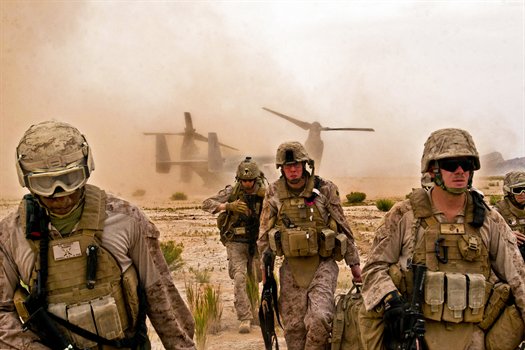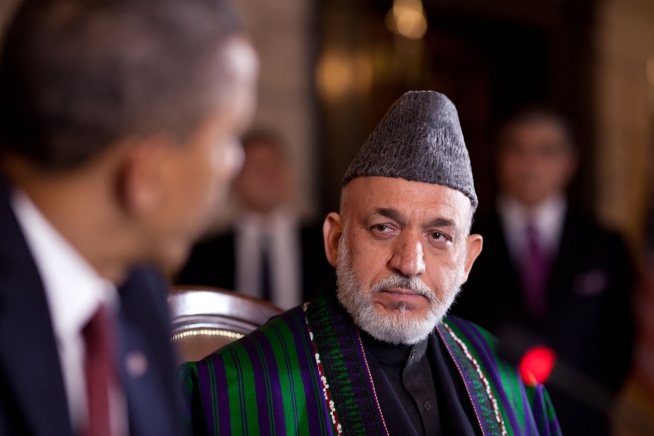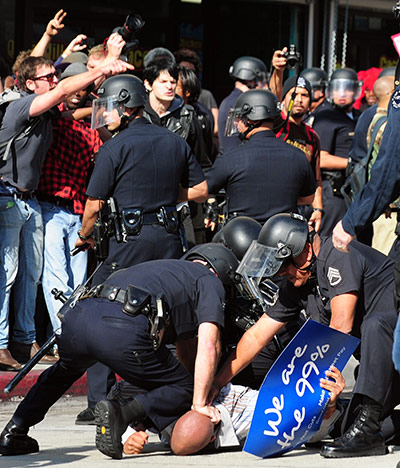Month: January 2013
Comparing America’s Failure in Afghanistan to the Soviet’s in 1989
The New Years experience tends to generate perspective and long-term thinking. At least, that’s the case with two unlikely opinionators: The New York Times and the Taliban.
 Both the Times and the Taliban have made strong, end of the year historical comparisons between the US withdrawal from Afghanistan, coming at least partially in 2014, and the Soviet withdrawal from Afghanistan in 1989.
Both the Times and the Taliban have made strong, end of the year historical comparisons between the US withdrawal from Afghanistan, coming at least partially in 2014, and the Soviet withdrawal from Afghanistan in 1989.
The young president who ascended to office as a change agent decides to end the costly and unpopular war in Afghanistan. He seeks an exit with honor by pledging long-term financial support to allies in Kabul, while urging reconciliation with the insurgency. But some senior advisers lobby for a deliberately slow withdrawal, and propose leaving thousands of troops behind to train and support Afghan security forces.
This is a nearly exact description of the endgame conundrum facing President Obama as he prepares for a critical visit by Hamid Karzai, the Afghan president, planned for early January.
But the account is actually drawn from declassified Soviet archives describing Mikhail S. Gorbachev’s closed-door struggles with his Politburo and army chiefs to end the Kremlin’s intervention in Afghanistan — one that began with a commando raid, coup and modest goals during Christmas week of 1979 but became, after a decade, what Mr. Gorbachev derided as “a bleeding wound.”
Separately, the Taliban released an emailed statement entitled “Quick Glance at 2012” in which they said “We can unmistakably state that 2012 in Afghanistan for the current occupation was exactly as 1986 was for the former occupation.” Reporting on the statement, AFP writes “The year 1986 is widely seen as a turning point in the Soviets’ ten-year presence in Afghanistan, with mujahideen attacks forcing Moscow on the defensive before the military finally left in 1989.”
The comparison is an important one, because in the West, the Soviet withdrawal from Afghanistan is universally regarded as retreat in the face of defeat. And Americans will have to watch, as 2013 and 2014 come and go, as their political leadership tirelessly claim that the war was worth it, the mission has been accomplished, and the troops are leaving with their heads high.
 But it’s not the case. As Afghan President Hamid Karzai said in October, America’s war in Afghanistan “will not be successful.” And the surge Obama ordered in 2009 has been a complete failure by every observable metric. A Pentagon report to Congress last month “found that violence in Afghanistan is higher than it was before the surge of American forces into the country two years ago,” The New York Times reported.
But it’s not the case. As Afghan President Hamid Karzai said in October, America’s war in Afghanistan “will not be successful.” And the surge Obama ordered in 2009 has been a complete failure by every observable metric. A Pentagon report to Congress last month “found that violence in Afghanistan is higher than it was before the surge of American forces into the country two years ago,” The New York Times reported.
US troops are leaving in 2014, not because the mission has been accomplished, but precisely because it hasn’t, and it can’t be.
That said, there is one major difference between the US in 2014 and the Soviet Union in 1989: the US is not leaving Afghanistan. During the vice presidential debates, VP Joe Biden said, “We are leaving [Afghanistan]. We are leaving in 2014, period. Period.” But all along, the US has been working behind the scenes with the Kabul government on an agreement that would govern the presence of at least 10,000 US troops well beyond 2014, perhaps until 2024.
Of course a major problem is that so long as any foreign occupation exists in Afghanistan, and so long as any Kabul government is propped up from abroad, the insurgency will remain alive and well. The insurgency has persisted for 11 years despite the efforts of the world’s most advanced military. And all signs tell me they will continue to fight to oust the occupier even after a “withdrawal” (which we now know really only means a smaller occupation).
So the Soviets perhaps were more prepared to face realities in their failed war than Washington. The trajectory of America’s failure rests on a much lengthier timeline than the Soviets on the eve of their demise. But it will be a failure, nonetheless.
War in Syria Such an Obviously Bad Idea, Even DC Insiders Know It
Why hasn’t the Obama administration intervened militarily in Syria? If you read this site with any regularity, you’ll know the answer to that. The great irony is that the major factors that make military intervention in Syria’s civil war impractical, unworkable, and dangerous are so obvious that the political, military, and intelligence establishment within Washington is unable to deny what we oddball libertarians at Antiwar.com constantly harangue about.
 Case in point: Aaron David Miller’s latest Op-Ed in The Washington Post. Miller has been a Middle East advisor to six Secretaries of State in both Republican and Democratic administrations and he is now vice president at one of DC’s most prominent think-tanks, the Woodrow Wilson International Center for Scholars. If ever there was a perspective that broadly reflected Washington, DC’s establishment, it would come from someone like Miller.
Case in point: Aaron David Miller’s latest Op-Ed in The Washington Post. Miller has been a Middle East advisor to six Secretaries of State in both Republican and Democratic administrations and he is now vice president at one of DC’s most prominent think-tanks, the Woodrow Wilson International Center for Scholars. If ever there was a perspective that broadly reflected Washington, DC’s establishment, it would come from someone like Miller.
Here’s his take on Syria:
The idea that Syria was anyone’s to win or lose, or that the United States could significantly shape the outcome there, is typical of the arrogant paternalism and flawed analysis that have gotten this country into heaps of trouble in the Middle East over the years.
Miller’s position on Syria isn’t all good; he entertains the notion that “perhaps [taking] a more active role far earlier in helping to organize a political opposition, even covertly,” might have helped. But, he says, from the beginning “all of the military options for intervention have been heavily skewed toward risk rather than reward.”
To stop the regime’s assault, let alone to topple it, would have required direct military pressure, most likely a massive air and missile campaign and probably an intervention force. Those, quite rightly, were never under serious consideration. Half-measures such as arming the rebels and instituting a “no-fly” zone carried risks but no identifiable rewards. It was never clear how a limited military response would shape events. U.S. planners could not be certain that a military response wouldn’t have pushed Russia and Iran to up the ante with more weapons. And with Washington seeking Moscow’s support to keep pressure on Iran’s nuclear program, a major escalation over Syria wouldn’t have helped.
Miller then rightly asks: “And who, exactly, would we have been arming?” Ah, the perennial question of the Syria conflict, which readers have seen scrawled over this site since the start of the Syria conflict. More explicitly, the point is that the only rebel groups with a chance against the Assad regime are mostly foreign fighters with ties to extremist groups and even al-Qaeda. Only psychotics advocate arming them.
“We don’t control history,” Miller writes. “And it’s time we attend to our own broken house instead of running around the world trying to repair everyone else’s.”
Blimey! That’s a blatantly non-interventionist sentiment coming straight from a quarter-century-long Washington establishment insider. Don’t be fooled, though. Washington truly wants to intervene in Syria to effect the outcome of the conflict and establish a nice client state there when the dust settles. The resistance to intervention is not for lack of want, but for lack of ability.
There is virtually no conceivable scenario where a US-led intervention in Syria’s mess benefits Syrians or Americans. That’s a reality not even typical Washington imperialists can deny.
Declassified: US Government Colluded With Big Banks to Monitor, Disrupt Occupy Protesters as ‘Criminal Threats’
According to recently released documents, the federal government monitored the Occupy Wall Street movement from its very inception, internally referring to it as a potential criminal and terrorist threat despite acknowledging the movement’s explicit rejection of violent forms of protest.
Via BoingBoing’s Xeni Jardin, the Partnership for Civil Justice Fund (PCJF) obtained through a Freedom of Information Act request documents that “reveal that from its inception, the FBI treated the Occupy movement as a potential criminal and terrorist threat even though the agency acknowledges in documents that organizers explicitly called for peaceful protest and did ‘not condone the use of violence’ at occupy protests.”
This is yet another example of how the federal government often views peaceful political activism as a threat, even a “terrorist” threat, and thus engages in covert surveillance and even physical aggression against them.
In October, the Senate Homeland Security subcommittee reviewed more than 600 reports that had come out of domestic surveillance centers and found that the government spy networks snooped on political activists and infiltrated groups that were peacefully exercising their constitutional rights to free speech, as opposed to fighting terrorist threats.
“The centers have made headlines for circulating information about Ron Paul supporters, the ACLU, activists on both sides of the abortion debate, war protesters and advocates of gun rights,” according to the Associated Press.
The FBI caught flack last year too when a massive probe into antiwar activists was revealed, as this Washington Post article explained:
The search was part of a mysterious, ongoing nationwide terrorism investigation with an unusual target: prominent peace activists and politically active labor organizers.
…The apparent targets, all vocal and visible critics of U.S. foreign policy in the Middle East and South America, deny any ties to terrorism. They say the government, using its post-9/11 focus on terrorism as a pretext, is targeting them for their political views.
They are “public non-violent activists with long, distinguished careers in public service, including teachers, union organizers and antiwar and community leaders,” said Michael Deutsch, a Chicago lawyer and part of a legal team defending those who believe they are being targeted by the investigation.
The documents obtained by PCJF are even more revealing than that, though. They show that the federal government cooperated with local law enforcement and major financial institutions of the kind Occupy was protesting against in order to crack down on the peaceful activism. Jardin:
According to the PCJF, the papers show the government partnered in this crackdown effort with financial institutions through the Domestic Security Alliance Council, an entity created by the FBI in 2005 that “enhances communications and promotes the timely and bidirectional effective exchange of information keeping the nation’s critical infrastructure safe, secure and resilient.”
And here is PCJF:
The PCJF has obtained heavily redacted documents showing that FBI offices and agents around the country were in high gear conducting surveillance against the movement even as early as August 2011, a month prior to the establishment of the OWS encampment in Zuccotti Park and other Occupy actions around the country.
“This production, which we believe is just the tip of the iceberg, is a window into the nationwide scope of the FBI’s surveillance, monitoring, and reporting on peaceful protestors organizing with the Occupy movement,” stated Mara Verheyden-Hilliard, Executive Director of the Partnership for Civil Justice Fund (PCJF). “These documents show that the FBI and the Department of Homeland Security are treating protests against the corporate and banking structure of America as potential criminal and terrorist activity. These documents also show these federal agencies functioning as a de facto intelligence arm of Wall Street and Corporate America.”
“The documents are heavily redacted, and it is clear from the production that the FBI is withholding far more material. We are filing an appeal challenging this response and demanding full disclosure to the public of the records of this operation,” stated Heather Benno, staff attorney with the PCJF.
Read the bullet point summaries at the PCJF site for a fuller understanding of how big banks colluded with big government to monitor and disrupt the Occupy movement. The FOIA’d documents can be read here.
Update: The New York Times has picked up the story, reporting that the FBI “used counterterrorism agents to investigate the Occupy Wall Street movement, including its communications and planning.” The emphasis here is important: note how the war on terrorism – presumably as far removed from a young semi-anarchist movement decrying the bankers’ state-granted privileges as can be imagined – is used as a blanket excuse for the government to control and suppress American citizens. Post-9/11 powers granted to the state in the context of fighting small groups of Arab Muslim militants plotting terrorist attacks against the US, are instead used to target politically active American citizens who have literally zero relation or connection to anything resembling “terrorists.”
The FBI apparently released a statement on the FOIA’d documents:
A spokesman for the F.B.I. in Washington cautioned against “drawing conclusions from redacted” documents.
“The F.B.I. recognizes the rights of individuals and groups to engage in constitutionally protected activity,” said the spokesman, Paul Bresson. “While the F.B.I. is obligated to thoroughly investigate any serious allegations involving threats of violence, we do not open investigations based solely on First Amendment activity. In fact, the Department of Justice and the F.B.I.’s own internal guidelines on domestic operations strictly forbid that.”
But Mara Verheyden-Hilliard, executive director of the Partnership for Civil Justice Fund, said the documents demonstrated that the F.B.I. had acted improperly by gathering information on Americans involved in lawful activities.
As is the case with virtually all cases of government surveillance of American citizens, we’re asked to trust that the spies possess a deep respect for the law, and observe it accordingly. Redactions and all.




